|
COVER STORY | IN
THE NEWS | FROM
THE PUBLISHER | STAGE
MATTERS | DIRT December 14, 2006
LAST WEDNESDAY, AT ST. JOSEPH HOSPITAL'S PUBLIC RELATIONS BUILDING IN EUREKA, CEO JOE MARK HAD GOOD NEWS TO REPORT: The hospital was now the owner of the Humboldt Radiology imaging center. The center's six radiologists -- three of whom sat beside Mark to issue the media briefing -- would be working for the hospital once again, almost two years to the day after the nonprofit Catholic institution broke its 42-year bond with the highly-regarded and profitable medical group. Back then, local hospital watchers agreed that driving the radiologists away was probably the biggest bonehead decision St. Joe administrators made in recent years, and there were many to choose from. The buyout announcement was fairly anticlimactic, at least for the reporters there that day. For months, it had been common knowledge that negotiations to buy the Eureka radiology clinic had been proceeding in earnest. This made the event quite unlike the other St. Joe press conference shockers of 2006: "Our CEO resigned today," "Anyone want to buy a hospital?" and, let's not forget, "We're $71.8 million in debt!"
This was apparent at the press conference announcing the hospital's renewed relationship with Humboldt Radiology. "The bottom line is we have a greater comfort level with the current administration," said Dr. Abe Pera, Humboldt Radiology's medical director. "It just feels like a comfortable fit to go back." Right: Joe Mark, CEO, St. Joseph Hospital. For the most part, Joe Mark left the speaking to others. The things he did say were careful and optimistic. "This is a real shot in the arm for the hospital," he said, and it was unclear whether the pun was intended or not. But as Pera had indicated, this happy turn of events -- like so many others in St. Joe's recent history -- was largely due to the efforts of the turnaround man who had been brought in to save the hospital from collapse. Mark has been serving as St. Joe's CEO since February, and he was permanently hired at the end of August. In that time, he has taken a deficit-ridden institution and put it in the black. He has started to repair relations with the medical community. He convinced the Sisters of Orange, St. Joe's SoCal parent institution, to assume the Eureka hospital's massive debt. He has, for the most part, restored the hospital's immense leverage in local medical policy matters. In short, and though the hospital acknowledges that it still faces significant challenges, St. Joe's doom-and-gloom days are safely in the past. The question now -- what happens next? Those affiliated with St. Joe's have good reason to feel optimistic, but others closely connected with two smaller acute-care hospitals -- Mad River Community Hospital in Arcata and Redwood Memorial Hospital in Fortuna -- are feeling the pressure to conform to St. Joe's controversial vision for the future. In 10 years, will there be just one major acute-care hospital -- in Eureka -- delivering babies, replacing knees, treating cancers and putting stents in hearts? Will the smaller hospitals in Fortuna and Arcata -- both a 25-minute drive from St. Joe's -- be converted to urgent care centers, outpatient surgery, rehabilitation and other clinics? That's Joe Mark's vision. But there are others in the medical community -- particularly people attached to Mad River and Redwood Memorial -- who have very different ideas.
Just nine months ago, St. Joseph Hospital announced it was in financial intensive care, hemorrhaging $500,000 every month for the past seven months. Without a dramatic turnaround, St. Joe's -- by far the North Coast's largest medical provider and the only hospital providing cardiac surgery, neurosurgery, major orthopedic surgery and specialized neonatal care -- would run out of operating capital by the fall and suck dry a $10 million emergency loan from the Sisters of Orange. St. Joseph administrators went public with the dire circumstances facing the Eureka hospital, telling the media and government leaders they were in deep trouble. The severity of the situation was outlined to the county Board of Supervisors in late March. Joe Mark, at the time serving as interim CEO, declared that in addition to all the reimbursement problems plaguing hospitals everywhere, St. Joe's carried too many employees compared to its dwindling number of patients. Layoffs were imminent, he said. The hospital could safely slash 90 to 110 full-time employees to recover $7 million for the hospital. That would give them a 2 percent operating margin. After that more cost-saving schemes would need to be rolled out to reach the health system's goal of 4 percent. "We will get to the 4-percent operating margin
-- I have no doubt about that," he told the Of course, nobody liked the sound of this. The general attitude was that St. Joe's created this mess through mismanagement and did not deserve a handout. And did they actually believe a tax would ever win a two-thirds majority vote? St. Joe's spent the next several months weighing its options -- sell the hospital, let the community take it over as a public health care district or struggle forward. The county supervisors called upon the Community Health Alliance to collect feedback from medical professionals and local stakeholders about St. Joe's future. There were pros and cons to each scenario, they found. Selling the hospital would bring a clean slate, but would not guarantee quality health care. A hospital district sounded good, but it would take years to set up and taxpayers' dollars. The plus side to St. Joe's continued sponsorship was that it had been in Humboldt County for many years, but could administrators be trusted to manage their finances better? While the CHA's report helped bring the medical community together to also tackle other issues vexing health care in Humboldt County, their results made little difference in the end. In late August St. Joe's announced it would soldier on, and continue its faith-based mission to provide health care. Then, in October, Mark rolled out the hospital's "Covenant for Change," announcing that the Sisters forgave the $71.8 million debt, which would be covered by the other hospitals in the St. Joseph Health System throughout California and Texas. The system's board decided that even though the Eureka hospital's operating margin was anemic, the hospital fulfilled an important role -- among the chain's 14 hospitals St. Joe's ranked highest in "mission effectiveness," which includes providing care to the poor. Now, eight months later, the hospital is operating in the black, planning to expand some services including a cancer center, and moving forward with plans for a new earthquake-reinforced building that will carry the hospital into the year 2030.
On Dec. 1, Mark sat down with the Journal to discuss the hospital's financial turnaround and also his vision of a "long-term sustainable health care model" for hospital care in Humboldt County. Mark -- a reserved Midwesterner who's been called a "straight-shooter" by some, and stubborn by others -- has almost three decades of experience in the hospital administration and consulting business. Former CEO Mike Purvis hired him in November 2005 as a subcontractor for Navigant Consulting, to resolve the hospital's operating losses. It was at that time, Mark recalled, that the hospital's finances really "began to tank." St. Joe's, he said, saw a big jump in bad debts and a simultaneous drop in patient numbers. Staffing was too high. Mark and his Navigant crew began a three-and-a-half-month process of establishing benchmarks within each department of the hospital. "I asked [Purvis] the first time he and I went out to dinner -- I said, are there any sacred cows or anything you don't want me looking at?" Mark recalled. "And he said `Absolutely not. It's an open book. You get in and dig.'" Three months later the health system's board asked Purvis to resign, as well as other top administrators. Mark took the helm. At that point, the hospital was $66 million in the red and things were only going to get worse. St. Joe employees immediately saw the writing on the wall. They knew Mark's arrival meant more layoffs were in the offing. Nurses called him a "hatchet man." They figured he'd hack away at the hospital, and that once his one-year contract was up he'd leave. In May the hospital laid off 74 employees. It was difficult, Mark said, but it needed to be done. "If I had it to do all over again I'd do it exactly the same way," he said. "We were able to say with integrity that we maintained our promise and our commitment that patient care would not be affected negatively one iota, contrary to what the California Nursing Association leadership said during that stretch." Since then, more savings have been found through tedious revenue audits. There were things the hospital hadn't been charging for -- like infusion services, for example. Mark estimates the hospital has uncovered $1 million a year in lost charges. On top of that, hiring in-house biomedical technicians to fix diagnostic equipment, like X-ray machines, rather than contracting from the outside will save them about $750,000. The hospital expects to save another $500,000 by having fewer choices of medical supplies so they can buy in larger volumes. "There's more opportunity yet," Mark said. "We have more work to do." In October, St. Joe's saw its strongest month ever, netting $799,000. However, Mark said, Redwood Memorial, which is part of the St. Joseph Health System-Humboldt County, during that month lost $65,000. Fortuna's recently sagging revenue has underscored, in Mark's eyes, the need to look realistically at the need for health care reform in Humboldt County. According to Mark, the North Coast simply does not have a large enough population to sustain three acute-care hospitals. The California Medical Association agreed with this assessment during a recent visit. Within 10 years, Mark figures, St. Joseph's inpatient facility will grow and the existing hospitals will shrink their services. This idea that they are in St. Joe's cross-hairs understandably has Redwood Memorial and Mad River Hospital concerned. Already, Joe Mark has dispatched a task force -- he's keen on task forces -- to examine whether Fortuna's service platform is viable for the long haul. Every conceivable way to integrate services between St. Joe's and Redwood Memorial, Mark said, is being explored. That means everything from obstetrics to the emergency department is under scrutiny. With a deadline for state-mandated seismic upgrades looming in 2013, and with all of the hospital's inpatient services due to be replaced by 2030, Mark is already having trouble justifying the numbers it would take to maintain its current capacity.
The task force is scheduled to wrap in January. In the meantime, Mark admits that "there's a lot of anxiety" among Eel River Valley stakeholders. One of them is Dr. Jim Killfoil, who is a partner at Redwood Pediatrics in Fortuna. In a letter to the Journal in August, Killfoil warned readers that downsizing Redwood Memorial could harm outpatient medical practices. "Fortuna could potentially see the loss of other physicians from its medical community as RMH becomes ill-equipped to handle many problems," he wrote. "This lack of services would also make it much more difficult to recruit new physicians to the Eel River Valley. Eventually, as physicians move or retire and replacements cannot be found, outpatient offices in Fortuna may be forced to close." Fortuna City Manager Duane Rigge said he believes residents are very attached to their community hospital. "There is quite a huge community, not only in the city of Fortuna but around this area, that have not only relied on this [hospital] but have been very, very generous in financial support over the years," he said. "To walk away now would seem to be inappropriate." Hundreds of thousands of dollars are raised annually for Redwood Memorial, far more than St. Joseph receives from Eureka. Even the land the hospital sits on was donated. And, typically, Redwood Memorial operates in the black, though this year its operating income was in the red $200,000 a month for three months. That was cause for alarm for Mark, and it touched off the formation of the task force. (A review of Redwood Memorial's income statements shows that the hospital ended fiscal year 2006 in June with a $770,000 net profit.) Skeptics, however, say that it's in St. Joe's best interest to highlight Redwood Memorial's problems so they can justify downsizing Fortuna's hospital.
"I believe that [your] Covenant would best be served by continuing the current hospital structure with an important exception, viz., that a `high tech' inpatient structure could be created to provide county-wide `high tech' care, such as joint replacement surgeries, cardiac catheterization surgeries, expensive imaging techniques, etc.," Gans wrote, adding that routine operations, including obstetrics, could therefore still be performed in Fortuna and Arcata. "The `high tech' center would become a referral center fed by existing hospitals. Legally, this hospital could be created as a health service entity that could allow for community, physician and outside investment." The location for such a high-tech medical center? The Mad River Hospital campus, which has 31 open acres just off Highways 101 and 299. The idea is that St. Joe's would abandon its $100 million plans to construct a new, earthquake-safe patient tower on its own campus, located in central Eureka, and invest in a single-story facility in Arcata. "I don't share that vision," Mark said, "that those three platforms are all viable, just given the population base and its lack of growth, and the indigent care up here and the poverty in this county. "There will not be three sustainable hospitals 10 years from now in this county," he said. "There's no way. I would be willing to sit and debate that with anybody. It just isn't there. Not unless the population explodes." It's additionally unfeasible because, according to Mark, such a "high-tech" facility would cost more than $275 million. (Gans argues that Mark is grossly inflating the price.)
"So by design," Ploss said, "you'd have a group of hospitals ... feed[ing] the cases that don't make money to another institution. That doesn't work. "I don't think there ever will be one high-tech hospital with three [acute care] hospitals. I think we're going to limp along with the system we have now, which is probably what will happen until, and unless, the financial constraints on the weaker players become so great that they choose to drop out or essentially [be absorbed] into a larger institution. If they choose to do that, it would have to be some form of joint ownership, where they do mostly outpatient stuff and give up their inpatient stuff to a larger facility." Mark said he has not altogether ruled out a partnership with Mad River, though the two hospitals are currently at an impasse. "I think there are opportunities for us to work together," he said. "But we've got to be able to come to the table and look at the best use of that 31 acres in Arcata relative to a vision we can all come to an agreement on ... Bring your land to the table -- that has value. We can bring system loans to the table and capital to get something together in Arcata. But we're going to have to agree on what that is. And we're going to have to address the issue of ownership."
In her "President's Message" essay in December's newsletter for the Humboldt-Del Norte Medical Society, Dr. Ellen Mahoney made a call for calm among her colleagues who were frustrated by St. Joe's decision to continue its ownership of the hospital. Taking sides, gossiping and continuing to demonize the hospitals would get them nowhere. "It seems that widespread structural change in our hospitals is no longer on the table," she wrote. "The window is closed for now, and those with bigger visions have to accept that." But if there was a silver lining, she reasoned, the crisis at St. Joe's presented an opportunity for dialog among physicians. They could now focus their efforts on other health care problems, like how to reverse the disturbing trend of primary care practice closures, recruiting new physicians and centralizing medical records. To drive home her argument, Mahoney interspersed her letter with lines from an Irish prayer she'd heard as a child, known to many as a central tenet of Alcoholics Anonymous: "Grant me the serenity to accept the things I cannot change, the courage to change the things I can, and the wisdom to know the difference." Above left: Dr. Ellen Mahoney at a Community Alliance Meeting.
For now, Mark is beginning to accept that he'll have to be patient to effect change. His 10-month negotiations with Humboldt Radiology have taught him as much, as have his discussions with area business leaders. Back in March, when he solicited their opinion on a county tax to fund emergency services, they all said the same thing -- not now. "They said, you gotta do two things," Mark recalled. "Keep making competent decisions ... and get outside the walls of the hospital, plug into the community and within two or three years, come back to us." l COVER STORY | IN
THE NEWS | FROM
THE PUBLISHER | STAGE
MATTERS | DIRT Comments? Write a letter! © Copyright 2006, North Coast Journal, Inc. |


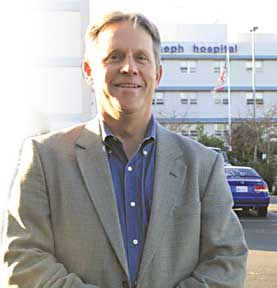 Nevertheless,
the occasion marked a positive turning point for the institution.
Not only would the hospital capture an additional $1 million
in revenue yearly, but, more importantly, the reunion proved
that St. Joe's -- and its new leadership -- was capable of regaining
trust and credibility with some members of a Humboldt medical
community that had steadily come to loathe it.
Nevertheless,
the occasion marked a positive turning point for the institution.
Not only would the hospital capture an additional $1 million
in revenue yearly, but, more importantly, the reunion proved
that St. Joe's -- and its new leadership -- was capable of regaining
trust and credibility with some members of a Humboldt medical
community that had steadily come to loathe it.
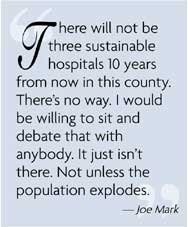 supes. "[But] it isn't going to
be enough. I'm here to tell you that with the seismic requirements
capital call, we're not going to be able to accumulate enough
4-percent operating margins to shoulder the full responsibility
of [a $100 million] seismic retrofit down the road. Absolutely
not. We are gonna need significant philanthropic gifts to support
the hospital. There's a possibility that we will come back and
approach you all in terms of asking for county support in a way
of some type of tax to support the hospital -- particularly targeting
the cost of emergency services and emergency transport in the
county."
supes. "[But] it isn't going to
be enough. I'm here to tell you that with the seismic requirements
capital call, we're not going to be able to accumulate enough
4-percent operating margins to shoulder the full responsibility
of [a $100 million] seismic retrofit down the road. Absolutely
not. We are gonna need significant philanthropic gifts to support
the hospital. There's a possibility that we will come back and
approach you all in terms of asking for county support in a way
of some type of tax to support the hospital -- particularly targeting
the cost of emergency services and emergency transport in the
county."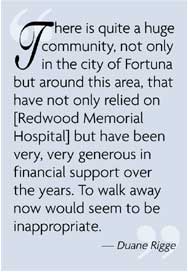 "Say
we committed to keep Redwood Memorial Hospital past 2030 -- we
would have to spend at least $50 million by 2013 to do that,"
Mark said. "We've got another $100 million we have to look
at up here [at St. Joseph]. Unless somebody steps up in a huge
way and writes a check for $50 million dollars in the Eel River
Valley, that isn't realistic. And I think the task force is starting
to struggle with that realism. If you wait until 2025-26 to start
construction, we're looking at $8 million a bed times 25 beds
-- it's a $200 million project. So [a person's] natural tendency
is to say, this is crazy, let's just do it now. But where's the
money going to come from to do it now?"
"Say
we committed to keep Redwood Memorial Hospital past 2030 -- we
would have to spend at least $50 million by 2013 to do that,"
Mark said. "We've got another $100 million we have to look
at up here [at St. Joseph]. Unless somebody steps up in a huge
way and writes a check for $50 million dollars in the Eel River
Valley, that isn't realistic. And I think the task force is starting
to struggle with that realism. If you wait until 2025-26 to start
construction, we're looking at $8 million a bed times 25 beds
-- it's a $200 million project. So [a person's] natural tendency
is to say, this is crazy, let's just do it now. But where's the
money going to come from to do it now?"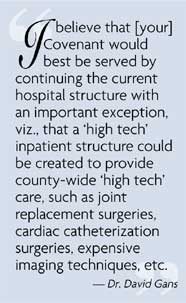 In late October, Dr. David Gans of Mad River
Hospital sent a letter to Mark conveying his concerns about the
CEO's vision to make St. Joe's the last acute-care hospital standing.
Gans' letter, which was also sent to the health system's board
and area physicians, sketched out his own vision for health care
in Humboldt.
In late October, Dr. David Gans of Mad River
Hospital sent a letter to Mark conveying his concerns about the
CEO's vision to make St. Joe's the last acute-care hospital standing.
Gans' letter, which was also sent to the health system's board
and area physicians, sketched out his own vision for health care
in Humboldt.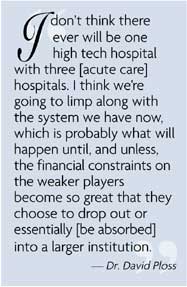 Eureka
cardiologist David Ploss -- an outspoken critic of St. Joe's
past monopolistic tendencies -- was among the recipients of Gans'
open letter to Mark. He said last week that the proposal seems
good in theory, but the fact remains that high-tech services
are money losers in medicine. Low tech -- in and out visits --
are the cases that actually pay. Quick surgical procedures therefore
buoy complicated services, like heart surgery or trauma care.
Eureka
cardiologist David Ploss -- an outspoken critic of St. Joe's
past monopolistic tendencies -- was among the recipients of Gans'
open letter to Mark. He said last week that the proposal seems
good in theory, but the fact remains that high-tech services
are money losers in medicine. Low tech -- in and out visits --
are the cases that actually pay. Quick surgical procedures therefore
buoy complicated services, like heart surgery or trauma care.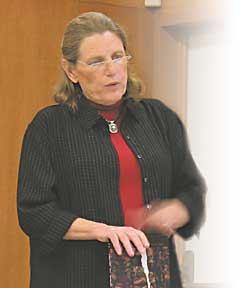
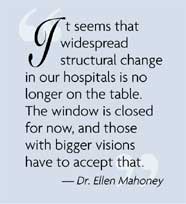 Next Monday, Dec. 18, the CEO of the Orange-based
St. Joseph Health System, Deborah Proctor, will make an appearance
at the Eureka hospital to sign and celebrate the "Covenant
for Change -- Creating a New Healthcare Model in Humboldt County."
Cynics would say that this occasion is the death knell for Mad
River Hospital and Redwood Memorial. Now that the Sisters have
made the commitment to keep St. Joe's alive, they won't allow
it to fail. From their perspective, St. Joe's won't be safe until
it's the last acute-care hospital standing. The landscape of
Humboldt County health care seems destined to change dramatically,
whether anyone likes it or not.
Next Monday, Dec. 18, the CEO of the Orange-based
St. Joseph Health System, Deborah Proctor, will make an appearance
at the Eureka hospital to sign and celebrate the "Covenant
for Change -- Creating a New Healthcare Model in Humboldt County."
Cynics would say that this occasion is the death knell for Mad
River Hospital and Redwood Memorial. Now that the Sisters have
made the commitment to keep St. Joe's alive, they won't allow
it to fail. From their perspective, St. Joe's won't be safe until
it's the last acute-care hospital standing. The landscape of
Humboldt County health care seems destined to change dramatically,
whether anyone likes it or not.